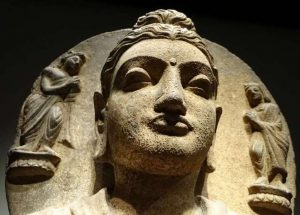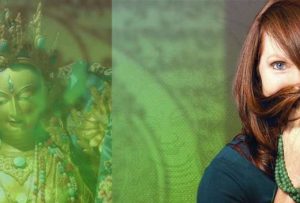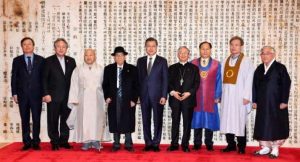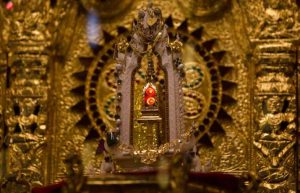In 2021, the Art Gallery of Greater Victoria (AGGV) in the Canadian state of British Columbia was scheduled to host an exhibition called In the Present Moment: Buddhism, Contemporary Art, and Social Practice. This exhibition was curated by Haema Sivanesan, a curator at the AGGV who has specialized in contemporary and historical art by South and Southeast Asians and their diaspora counterparts. The COVID-19 pandemic forced the gallery to delay this remarkable exhibition to 2023. Fortunately, between last year and next, the AGGV has released a volume, edited by Sivanesan, by the same name as the exhibition. The book, supported by The Robert H. N. Ho Family Foundation, constitutes a collection of essays written by Sivanesan, Canadian writer Lydia Kwa, York University English professor Marcus Boon, and Dutch artist Louwrien Wijers. It also has a transcript on a discussion about “Buddhism and Socially Engaged Art Practice,” which was a moderated conversation between artists and scholars at the University of Victoria in 2019. At the end of the book is an up-to-date reading list of selected artists’ writings on Buddhism.
Sivanesan’s research over her curatorial career has so far covered the North American context. “Embedded within that is a long history of East-West exchange and the globalization of modern Buddhism,” she explains, reflecting on the exhibition’s objective and the contents of the book: “However, I really would be very interested to develop this research by looking at the work of artists in Asia. I think there would be comparable approaches, but also, I expect, some important differences that would help to deepen our understanding of the impact of Buddhism on developments in contemporary art.”

Driftwood (Heart Sutra), 2019.
Performance document: India ink on driftwood; 90 mins.
Performed on October 27, 2019 as part of In the Present Moment: A Research Convening, Visual Arts Building, University of Victoria.
Courtesy of the artist.
Photo: Laura Gildner
The excellence of the artworks chosen for In the Present Moment only demonstrates that nothing can quite replace a physical, in-person encounter with the exhibition in 2023. In this informative book, Sivanesan notes that the exhibition and the volume both explore the “concept of art as a multi-sensory, lived, and embodied relational experience that is attuned to the dynamic nature of the world, rather than as a form of representation.” (3) When encountering the art of the exhibition’s artists, viewers are invited to “self- and social actualization.” (2)
This concept has roots in the principles that inform Buddhist art, Buddhism’s influence on Western artists, and the cross-cultural influences that have shaped Buddhist concerns in the West and more specifically North America. It also denotes a different way of encountering art, no more “simply looking at a work of art with a disinterested gaze.” (71) Curiosity and open-mindedness are required not simply in terms of the art or subject matter itself, but in terms of the methodology of making and viewing art.

Ink and paint pigment on mulberry paper; 190.5 x 96.52cm.
Courtesy of the artist, collection of Tad Freese, San Francisco.
Photo: Justin Wonnacott
In her essay for the book, “Towards Experiencing Emptiness: Buddhism as an Artistic Methodology,” Sivanesan traces an artistic lineage that manifests as creative engagement with the complex and abstract teachings of Buddhist philosophy. This engagement, in turn, contributed to the spread of Buddhism in the West, and, more profoundly, made the artists, “conduits for processes of East-West exchange” and facilitators of “cultural expression” for Buddhism. (7) Yet how is Buddhism a methodology for contemporary art practice? Sivanesan observes: “I believe that contemporary art, particularly since the mid-20th century, is a practice of inquiry—using the imagination to inquire into social, political and cultural issues, and into the human condition. In general, professional visual artists are trained to develop their practice of art in this way. What is specific to the artists that I have been researching has to do with the way the practice of art intersects with the inquiry into Buddhism. I argue that these artists draw on Buddhism as a methodology of art practice, in the sense that Buddhism provides a framework of thinking and a system of methods that shapes the inquiry that results in a work of art.”

Rose Mirror Mandala, 2013.
Installation; roses, bodhi leaves blue mirror and glass; dimensions variable.
The Temptation of AA Bronson, Witte de With Centre for Contemporary Art (now Kunstinstituut Melly), Rotterdam, Netherlands.
Courtesy of the artist.
Photo: Matthias Herrman
Sivanesan proposes that Buddhism has contributed in important ways to what has been referred to as the “dematerialization” of the work of art. “This means that since the mid-1950s, Buddhism (and Zen in particular) played an important role in the development of conceptual art,” she explains. “Conceptual art is more focused on the idea rather than the object or image. Central to this is the experience of a work of art, which may result in an experiential opening of the mind, as you put it. For example, you could think of John Cage’s famous composition 4’33” (1952) or any of Yoko Ono’s instruction pieces published in the early 1960s. These artists used ordinary language and simple gestures to bring an idea or visual image to mind—as ‘mind art,’ we could say, often without producing any material object or image. The experience of traditional or representational art is quite different to that of conceptual art.”
Here, she draws a distinction: “Conceptual art is not necessarily easy for the average art museum visitor. So, I’m not sure that it is fair to compare with traditional painting and sculpture. But the conceptual art that many of these artists have been engaged with can lead to a more profound experience, in my view. To some extent, I think this is because many of these kinds of works have an interpersonal aspect to them—so there is a manner in which the viewer is directly engaged or implicated in the realization of the work of art. The impact is cognitive—a kind of realization or opening of the mind—rather than a simply visual or aesthetic experience.”

Learning ● Diamond Sutra, 2013.
Durational performance: 120 mins.
Documentation of performance at Wie Kultur, Berlin, Germany, May 17, 2013.
Courtesy of the artist
Photo: Julia Baier
What of the “real world” in which art manifests, in particular, a post-COVID world that finds itself in a series of global crises and upheavals? “This is a difficult question because artists tend to develop their inquiries in individual ways. But in general, contemporary artists who are engaged with Buddhist ideas are also very much concerned with the issues that are shaping the contemporary world—climate change and environmental crises, refugee crises, issues of social and political trauma and healing, inter-cultural healing, and so on,” says Sivanesan. “Obviously, artists can’t solve these crises but they can humanize some of these issues, and working with social practice as an approach, they can put us in relation to these issues—either to engage us with these issues more deeply, or to offer levity and respite.”
In the Present Moment is much more than just an accompanying text to the exhibition—its rich and insightful essays deserve analysis and commentary on their own. In particular, I wish to explore in a future piece the discussion about Buddhism and socially engaged art practice toward the end of the book. In the Present Moment is a wonderful volume on an upcoming exhibition, but is an informative collection of essays on contemporary Buddhist art. The essays written by the contributors push Buddhist art’s conceptual boundaries, and in doing so challenge us to think of Buddhist art in distinctive and innovative ways. Yet this is only the beginning. When the exhibition is finally open to the public next year, visitors will go to the AGGV and encounter art, hopefully in the way Sivanesan has suggested: by allowing the encounter to touch one’s interior, the most important locus of the transformational. The engagement with art, an outer form filtered through the five aggregates, stimulates meditation of the general kind in the interior self. In the Present Moment is a rich volume that offers a multifaceted, nuanced, and thoughtful contemplation from many diverse voices.

The Hands of the Compassionate One, 1993.
Viewer activated mural transformed in 3 stages; acrylic on canvas with tassels; Closed: 274.32 x 152.4cm (closed); 274.32 x 213.36cm (fully opened).
Surrey Art Gallery 1999.01.01.
Photo: Al Reid Studio
References
Sivanesan, Haema (ed.). 2022. In the Present Moment: Buddhism, Contemporary Art, and Social Practice. Vancouver: The Art Gallery of Greater Victoria.
Related features from BDG
Abstract Meditations and Artistic Contemplation, with Françoise Issaly
Art, Culture, and Healing the World: A Conversation with Haema Sivanesan
Related news from BDG
Art Gallery of Greater Victoria to Host Research and Exhibition Project on Contemporary Buddhist Art















